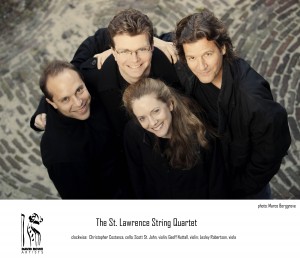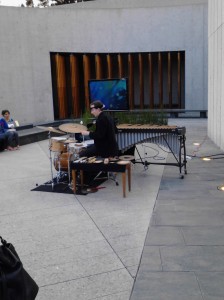Mainly Mozart: Combining Neuroscience and String Quartets
San Diego’s highly respected Mainly Mozart Festival is celebrating its 25th anniversary this season not by patting itself on the back with indulgent retrospectives, but by inaugurating new series and expanding the concept of what a music festival can do.
Saturday (May 18) in the Auditorium of La Jolla’s TSRI and on its inviting plaza, the festival presented a pair of stimulating lectures in its new Mozart and the Mind series; offered an “intellectual playground” of interactive installations exploring current research on music and the brain, and then presented a stirring concert by the St. Lawrence String Quartet. During the exploration of the music and the brain installations, patrons could acquire a light meal from catering trucks in the driveway, and drinks were provided on the house.
By the time the St. Lawrence players were ready to perform their J. S.
Bach, Haydn and Mendelssohn, this every-seat-filled audience was far more animated and engaged than the typical reserved audiences that congregate for local string quartet concerts, and they cheered the St. Lawrence Quartet as if they were a popular rock band playing an arena. In my experience with the St. Lawrence String Quartet, their playing regularly deserves such a response, but their typical placid audiences aren’t ready to go there.
I suggest that Mainly Mozart is onto something important, especially with its Mozart and the Mind venture, because music lovers are fertile audiences to receive information on the latest scientific research about music and the brain. Churches and temples have long celebrated the spiritual aspect of musicmaking; it is now time for science and the university to advance music’s biological significance.
Adam Gazzaley, a neuroscientist from the UC San Francisco faculty, talked about the human brain’s fundamental rhythms and periodicity, and Northwestern University’s Nina Kraus discussed her experiments that show how early music study—even if the individual does not continue such study as an adult—provides significant longterm benefits to hearing and cognition.
Opening their concert with Haydn’s F Minor String Quartet, Op. 20, No. 5, the St. Lawrence players tore in this dark quartet with an impassioned fury we expect from middle Beethoven. First violinist Geoff Nuttall tended to dominate the ensemble, but not because his colleagues—violinist Scott St. John, violist Lesley Robertson and cellist Christopher Costanza—were subservient. Rather, he challenged them to match his zeal for Haydn.
For Haydn’s deliciously anachoronistic fugue of the Finale, the four players found an apt Baroque restraint that allowed the democratic complexity of this contrapuntal style to prevail, an approach that adroitly fit the three excerpts selected from Bach’s “Art of Fugue” that followed the Haydn quartet.
Introducing the Bach, Nuttall had the audience sing the “Art of Fugue” theme as part of his verbal program notes. Their account[php snippet=1] of movement No. 1 struck me as deliberate and cautious, although for their second movement (No. 4) they displayed a more flowing, buoyant legato technique. The racing tempo and virtuoso turns of their finale (No. 9) made me wonder if the Leipzig string players of Bach’s time possessed the technique to realize this piece with such precision and polish.
All of the passion and finesse that St. Lawrence promised in the opening of their Haydn quartet came to rewarding fruition in Felix Mendelssohn’s String Quartet in E Minor, Op. 44, No. 2. The St. Lawrence String Quartet has played San Diego before, but this was the first season they have appeared with Mainly Mozart. I will be surprised if we don’t hear them again in one of Mainly Mozart’s expanded offerings.

Ken Herman, a classically trained pianist and organist, has covered music for the San Diego Union, the Los Angeles Times’ San Diego Edition, and for sandiego.com. He has won numerous awards, including first place for Live Performance and Opera Reviews in the 2017, the 2018, and the 2019 Excellence in Journalism Awards competition held by the San Diego Press Club. A Chicago native, he came to San Diego to pursue a graduate degree and stayed.Read more…


